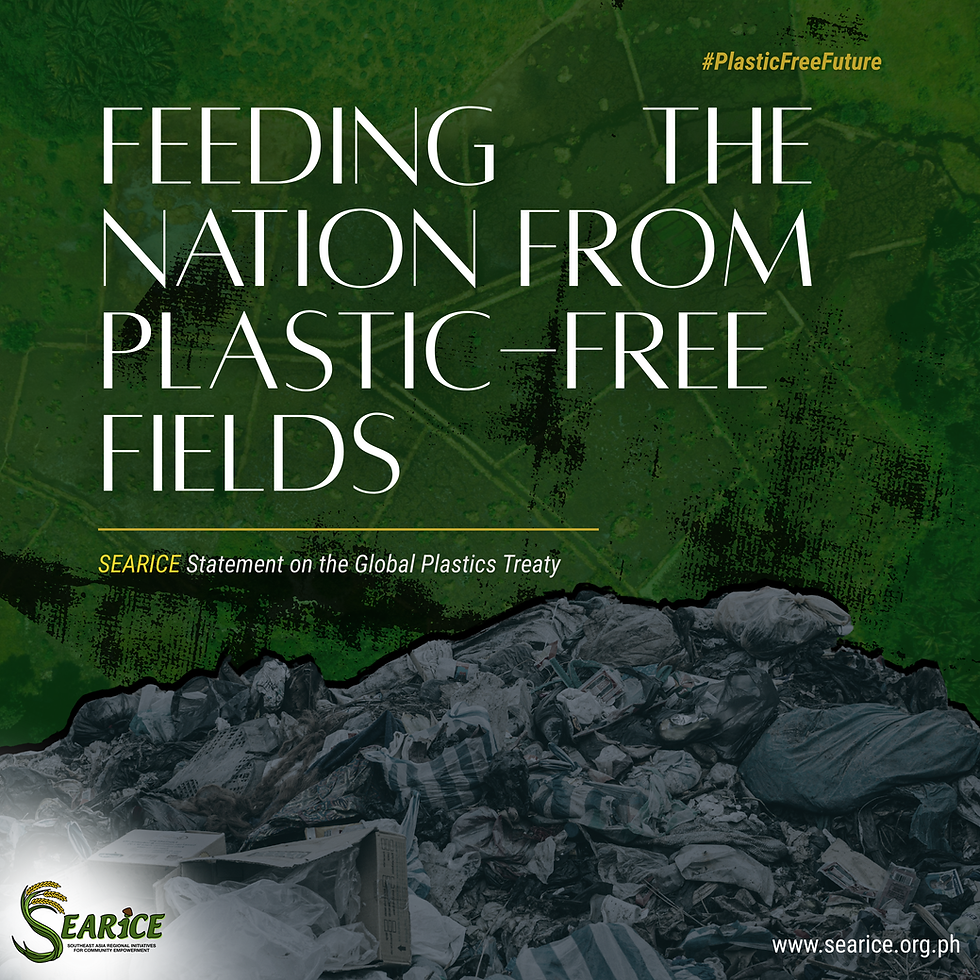SEARICE statement at the 18th meeting of the Convention on Biological Diversity (CBD) Subsidiary Body on Scientific, Technical and Technological Advice (SBSTTA)
- SEARICE Staff
- Jun 28, 2014
- 3 min read
Updated: Sep 19, 2024
SEARICE Position Statement on Biofuels and Biodiversity (Item 9.5)
On the need for a definition of “sustainable and unsustainable production and use of biofuels,” SEARICE agrees with the findings stated in documents SBSTTA/18/15 and SBSTTA/16/inf/32 that “defining the full suite of parameters for the end point of sustainability, particularly in such a diverse sector as agriculture, is not feasible” and would require trade-offs based on a nation’s priorities and development agenda. In this case, food security and energy security would have to be seen not just as competing interests, but as also potentially diverting resources from the fulfillment of a basic human right, particularly the right to food, of a particularly vulnerable group (recall food price crisis of 2008, de Schutter report). It requires the identification of multiple and interlocking drivers of biodiversity loss such as international trade, and various incentives provided by government. The identification of criteria for the appropriate direction for sustainable agriculture as a whole would be more feasible.
SEARICE supports the use of indigenous and local knowledge in creating and evaluating opportunities for the production and use of biofuels, particularly because indigenous and local communities can contribute significantly to the development of integrated bioenergy approaches. Therefore, it must be pointed out that land tenure of indigenous communities and participation of local communities are essential components in their empowerment in decision-making on the use of land or waters. In this regard, SEARICE recommends that land tenure, the participation of indigenous and local communities, and the use of their traditional knowledge should be included in the criteria for sustainable production and use of biofuels.
The criteria for sustainable production and use of biofuels should be closely related to the search for a definition or criteria for identifying “critical ecosystems, areas of high biodiversity value, cultural, religious and heritage interest and important to indigenous and local communities.” SEARICE raises its concern over the criteria used for identifying Key Biodiversity Areas. Paragraph 32 of UNEP/CBD/SBSTTA/18/15 states that the Joint Task Force established to convene a consultation process to consolidate scientific criteria and methodology to identify sites of global significance for biodiversity, also known as “Key Biodiversity Areas”, has focused largely on natural science based criteria and thresholds. While SEARICE welcomes the guidance being provided by the IUCN in identifying Key Biodiversity Areas, considerable attention should also be given to sociocultural and socioeconomic criteria, and how and by how much these relate to the natural science based criteria, given that agriculture is a necessary human intervention in strictly natural processes. In this regard, the work of the WG8j in monitoring traditional livelihoods, such as farming, as indicators of traditional knowledge and sustainable use, may be instructive. Further, the work of FAO on Globally Important Agricultural Heritage Systems should be taken into account, and may be more relevant in minimizing or avoiding negative impacts of indirect land use change.
To this end, we propose the following recommendation:
Strongly urge the task force to identify sociocultural and socioeconomic criteria for identifying Key Biodiversity Areas.
Acknowledging the important contribution of smallholder farming families in conserving biodiversity, and in providing a myriad of ecosystem services that are vital for the survival of the human race, such as food and nutrition, the Key Biodiversity Areas need to include the landholdings of smallholder farmers. These landholdings should not be displaced, indirectly or directly, for purposes of biofuel production. [Ends]


